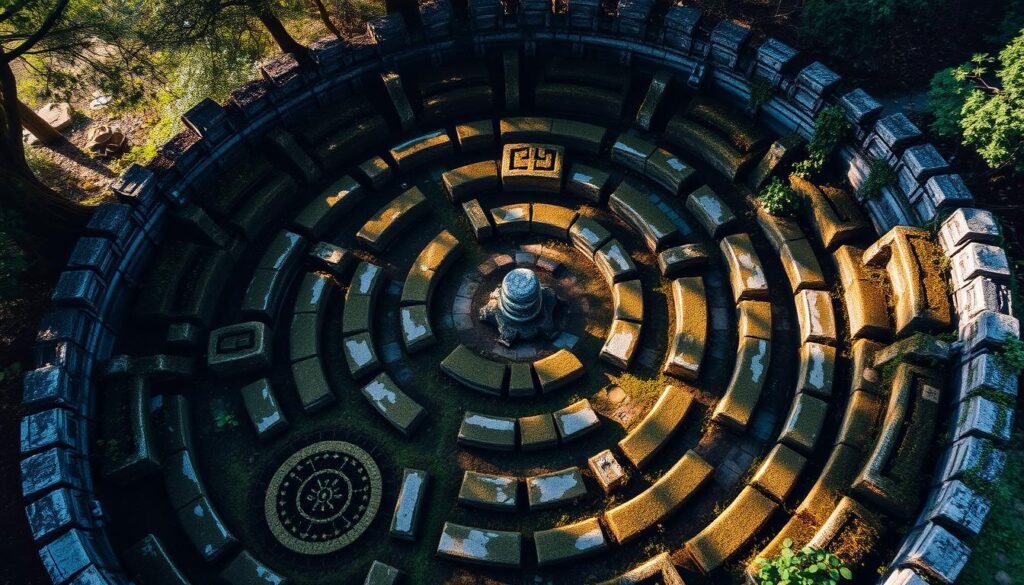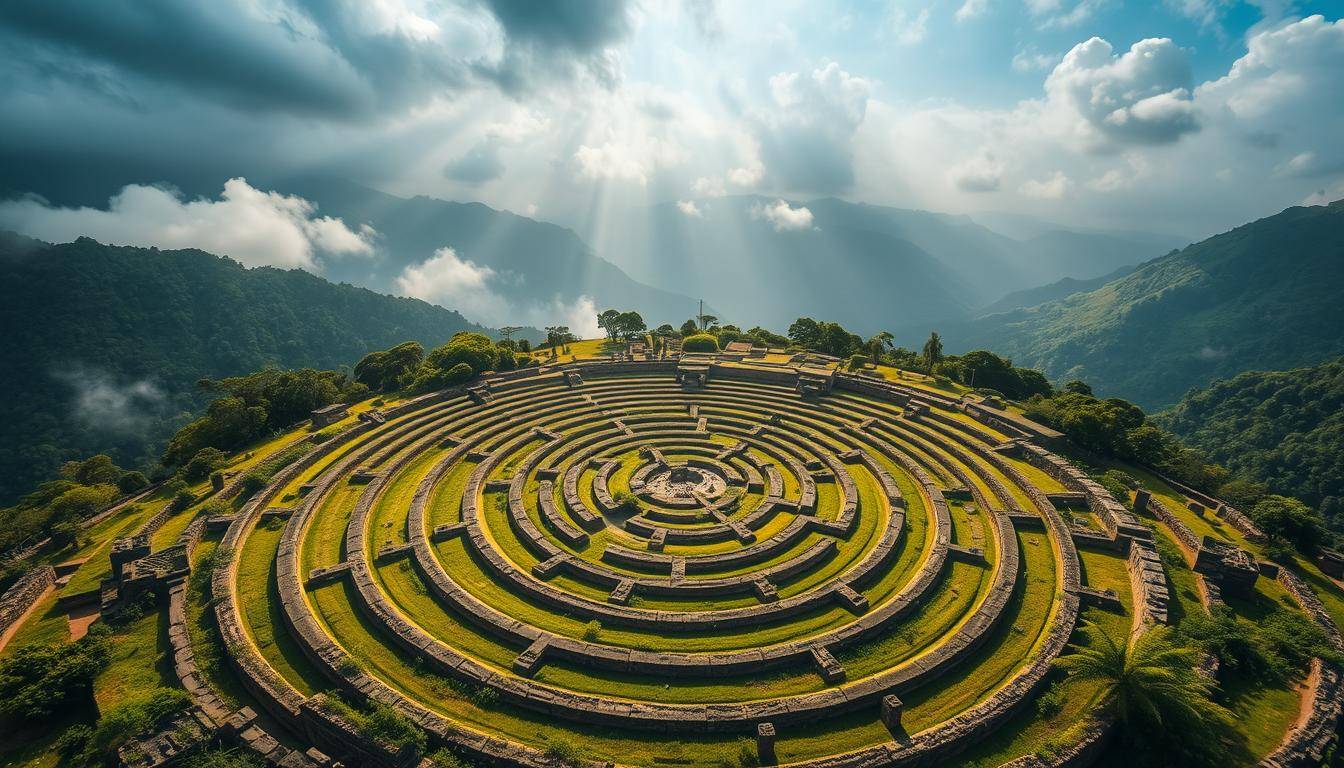“The labyrinth is a walking meditation, a path of prayer, and a ritual that connects us to our true selves.” – Rev. Lauren Artress, Episcopal priest and founder of Veriditas
Labyrinths have been around for thousands of years, long before Christianity. The oldest known labyrinth is from 2000 BCE in Spain. Walking a labyrinth can be deeply spiritual, offering peace and a connection to something greater.
Rev. Lauren Artress calls labyrinth walking an embodied prayer. It helps the body become aware and connected.
Key Takeaways
- Labyrinths are ancient spiritual traditions that predate Christianity
- Walking a labyrinth can be a profound, transformative experience
- Labyrinths offer a path to inner peace, mindfulness, and spiritual connection
- The practice of labyrinth walking is an embodied prayer or meditation
- Labyrinths have the power to heal, inspire, and facilitate personal growth
Understanding Ancient Labyrinth Origins and Sacred Geometry
Labyrinths have been around for 3-5,000 years, with roots in pre-Christian times. These structures are inspired by nature’s patterns, connecting with our bodies and minds. The Seven Circuit Classical labyrinth is the oldest known design, filled with sacred geometry and ancient symbolism.
Pre-Christian Roots and Cultural Significance
The labyrinth’s history goes back to before Greek times, especially during the Minoan era. The famous Minoan labyrinth in Crete, made by Daedalus for King Minos, shows their importance. Many cultures have used labyrinths for spiritual and healing rituals.
Mathematical Principles in Sacred Design
The shape of a labyrinth is thought to create a healing energy field. The classic 7-circuit labyrinth follows a mathematical pattern. This pattern aligns with our sacred geometry and vibrational frequencies, symbolizing transformation and vision.
Early Ritualistic Uses
Ancient cultures worldwide, from Spain to Peru, have used labyrinths in their ritualistic uses and ceremonies. The labyrinth’s path represents life’s journey, with the center being a sacred or divine space. Walking it was a form of meditation, connecting with the ancient symbolism and spiritual energy of these structures.

“The labyrinth is a metaphor for life’s journey, a sacred space where the mind can quiet and the spirit can soar.”
The Spiritual Power of Ancient Labyrinths: A Journey Through Time
Labyrinths have fascinated people for thousands of years. They are powerful tools for spiritual growth and personal change. These symbols are found across cultures and have stood the test of time.
The circular shape of the labyrinth shows unity and connection. Walking it, you feel like you’re on a journey of life. It leads you to moments of clarity and self-discovery.

Labyrinths have been used in many cultures and religions. From ancient Greece and Egypt to medieval Europe, they were sacred spaces. Walking the labyrinth was like a spiritual pilgrimage, mirroring life’s ups and downs.
Today, labyrinths still inspire those seeking a deeper connection or a moment of peace. They offer a timeless way to grow and transform. Whether you’re facing a big change or just need some quiet, the labyrinth can be a powerful experience.
“The labyrinth is considered an ancient symbol for wholeness and a spiritual journey.”
When you walk a labyrinth, be open to what you might discover. Let the path guide you inward. Trust that it will lead you to understanding, healing, and peace.
Medieval Cathedral Labyrinths and Christian Symbolism
For centuries, medieval cathedrals have been home to captivating labyrinths. Each one shows the deep connection between faith, architecture, and spirituality. The famous labyrinth at the Chartres Cathedral in France is a key example. It links Chartres Cathedral, medieval labyrinths, and Christian symbolism together.
The Chartres Cathedral Legacy
The Chartres Cathedral labyrinth was built in the 13th century. It has eleven circuits and twenty-eight 180-degree turns. This design was a substitute for the hard pilgrimage to Jerusalem. It allowed worshippers to journey spiritually without leaving the cathedral.
Pilgrimage Symbolism and Sacred Architecture
The Chartres Cathedral labyrinth’s layout holds deep Christian symbolism. The cross-shaped pattern and the number of circuits show sin and imperfection. These can be overcome by Christ’s saving power.
The winding path represents the spiritual journey’s challenges. The center, where you arrive, means enlightenment and divine connection.
Religious Interpretations and Meanings
Labyrinths in medieval cathedrals have sparked debate in the Christian tradition. Some see them as tools for meditation and self-discovery. Others worry about their possible pagan origins.
Despite these debates, the Chartres Cathedral labyrinth is a powerful symbol. It represents the pilgrimage experience and the quest for spiritual transcendence.
Walking Meditation and Mindfulness Practices
Labyrinth walking is a deep form of meditation that boosts mindfulness and spiritual growth. As you walk the path, find your own pace. Notice the feelings, thoughts, and sensations that come up. This can lead to deep insights and spiritual moments, helping you focus and quiet your mind.
Try breathing in sync with your steps or use mantras like “Be still and know.” Visualize images to stay present. These practices help you focus, become more aware, and connect your body, mind, and spirit.
Whether you’re new or experienced, labyrinth walking is a powerful tool for spiritual practices and mindful movement. It helps you slow down, quiet your mind, and find inner peace. This can lead to personal growth and self-discovery.
“The labyrinth is a metaphor for the journey of life. Walking it is a way to focus, to find the path, to be present, to discover the center and return.”
Labyrinths come in many sizes and patterns around the world. They offer a chance for spiritual and meditative experiences. Walking alone or with someone can bring you closer and help you understand relationships better.
Start your labyrinth walking journey to slow down and grow in mindfulness. This ancient practice can help you understand yourself better, find peace, and connect with the divine.
Energy Centers and Chakra Alignment in Labyrinth Walking
Many spiritual seekers believe ancient labyrinths can align and balance the body’s energy centers, or chakras. Walking the paths can start a journey of energy healing, chakra balancing, and deep vibrational healing.
The circular paths and turns in a labyrinth create special energy flow patterns. These patterns can deeply affect your well-being. As you walk, you’ll slowly wake up and connect your seven principal chakras, from the root to the crown.
Vibrational Healing Properties
Labyrinths are built with stones and materials that have natural healing energies. These include ancient petrified wood, rose quartz, and opal onyx. These elements add to the labyrinth’s vibrational healing properties. They create a space that can deeply change your physical, emotional, and spiritual states.
Energy Flow Patterns
The labyrinth’s layout is designed to match the body’s energy patterns. For example, the seven-circuit labyrinth matches the seven chakras. An 11-circuit labyrinth connects to the root-to-crown chakras and the elements. Walking these paths can lead to a deep energy flow and integration of your subtle energy system.
The labyrinth is a powerful tool for personal growth. It guides you to understand the connection between mind, body, and spirit. By practicing this ancient way, you can unlock the energy healing and chakra balancing benefits that have helped seekers for centuries.
The Divine Feminine Connection in Labyrinth Traditions
Many labyrinth traditions are rooted in the Divine Feminine or Goddess worship. For some, the labyrinth is seen as the Mother, the Goddess, or the Divine Feminine. This view helps balance traditional religious practices and reconnects with ancient wisdom that honored the feminine divine.
The story of Ariadne and Theseus from ancient Greek mythology is fascinating. It shows the labyrinth’s symbolic power. Ariadne’s red thread guides Theseus, highlighting the role of intuition and femininity in overcoming challenges. The themes of betrayal and abandonment add to the myth’s depth, showing the complexities of human relationships.
The labyrinth is seen as a symbol of our inner struggles and trials. The Ariadne and Minotaur story parallels other myths with powerful female figures. Symbols like the sword for truth and the red thread for intuition offer insights into personal transformation and spiritual growth.
By embracing the divine feminine in labyrinth traditions, we tap into ancient wisdom. This allows us to reclaim the sacred feminine in our own journeys of self-discovery and healing. The labyrinth serves as a powerful metaphor for the human experience, inviting us to explore our inner landscapes with compassion, courage, and reverence for the divine.
| Expert Profile | Credentials |
|---|---|
| Mary Ann Wamhoff |
|
“The labyrinth becomes a powerful metaphor for the intricate and multifaceted nature of the human experience, inviting us to navigate the complexities of our inner landscapes with compassion, courage, and a deep reverence for the divine.”
Modern Applications of Labyrinth Healing
Ancient labyrinths are now used in new ways. Hospitals, mental health centers, and prisons use them to help people. They see the benefits for mental health and stress relief.
Therapeutic Benefits
Walking a labyrinth can greatly improve your well-being. It can lower anxiety and help you focus better. It also brings calm and clarity.
The movement and meditation of walking a labyrinth are good for your heart and stress levels. It can lower blood pressure and heart rate. It also reduces cortisol, the stress hormone.
Mental Health Applications
Labyrinth healing is used in healthcare as a therapy. It helps people find new ways of thinking. It’s good for those with depression, anxiety, and trauma.
The labyrinth boosts right-brain activity. This is helpful for mental health challenges. It helps people think more creatively and intuitively.
Stress Reduction Techniques
The labyrinth is a calm place in a busy world. It helps you slow down and focus on yourself. Walking it is a mindful practice that reduces stress.
It helps you relax and think deeply. This makes it a great tool for stress relief. It promotes overall well-being.
| Location | Labyrinth Type | Significance |
|---|---|---|
| Chartres Cathedral, France | 11-circuit Labyrinth | A powerful meditative and spiritual tool for pilgrims and visitors |
| Christ Church, Colliers Wood, UK | Classical 7-circuit Labyrinth | A labyrinth mown into the grass, providing a peaceful walking meditation experience |
“The labyrinth is a symbol of the journey inward, providing experiences like spiritual awakening, solace, mindfulness, and insights into life challenges.”
Sacred Rituals and Ceremonial Practices
The ancient labyrinth has been a key part of many spiritual traditions. It’s a place for deep personal change, group meditation, and celebrating life’s big moments.
Walking the labyrinth is a big part of sacred rituals and ceremonial practices. It lets people go on a journey inside themselves. Whether alone or with others, these spiritual ceremonies help set goals, let go of old habits, and connect with something greater.
People use the labyrinth for prayer, thinking deeply, or aligning their energy. The path reminds us of life’s cycles, helping us find new beginnings. It’s used for many reasons, like welcoming new life, celebrating seasons, or honoring our ancestors.
By exploring the labyrinth, we connect with a long history of wisdom. It teaches us to slow down, calm our minds, and feel more connected to nature.
“The labyrinth is a metaphor for the journey to the center of your deepest self, and back out into the world with a broadened understanding of who you are.”
When you walk the labyrinth, you start a special journey. It’s a chance for growth, insight, and finding your purpose. This ancient practice teaches us to trust the journey, let go, and follow its wisdom.
Personal Transformation Through Labyrinth Walking
Start a deep journey of personal change with labyrinth walking. This ancient practice lets you reach your inner self. It helps you grow spiritually and discover yourself.
Many people have had life-changing moments and emotional healing walking the labyrinth. Brian Copeland, a famous actor and playwright, found peace and hope through it during a tough time.
The labyrinth is like your inner world’s twists and turns. Walking it, you focus on yourself, away from the world’s noise. This journey helps you find hidden parts of yourself, leading to clarity and purpose.
“The labyrinth is a tool for personal transformation, guiding you through the maze of your own life experiences and helping you find your way back to your authentic self.”
Labyrinth walking is great for deepening your spiritual practice, facing challenges, or exploring yourself. Every step is like a step in your life, helping you understand yourself better.
Let the labyrinth’s wisdom guide you to personal growth. Step onto the path and discover yourself, your purpose, and the endless possibilities ahead.
Ancient Mystical Traditions in Contemporary Practice
Many today are drawn to ancient mystical traditions for spiritual growth. The world is complex, and these timeless practices offer wisdom. The labyrinth, with its long history, is a key tool for personal change and spiritual connection.
Modern Interpretations
Today, labyrinths blend old traditions with new views. Groups like Veriditas, led by Lauren Artress, list hundreds of labyrinths in the U.S. They see labyrinths as a spiritual aid. This movement is growing, adapting ancient wisdom for today’s seekers.
Integrating Traditional Wisdom
Labyrinths are gaining popularity, mixing old wisdom with today’s spiritual needs. Pagan rituals often include labyrinth walks, celebrating life’s cycles. Churches worldwide also see labyrinths as a spiritual path, connecting us to the divine.
The labyrinth stands as a symbol of the link between old and new spirituality. It offers a timeless path to self-discovery and finding the divine within.
| Ancient Mystical Traditions | Contemporary Spirituality |
|---|---|
|
|
“The labyrinth is an archetypal spiritual tool found across many times and cultures, serving as a bridge from the mundane to the divine.”
The interest in ancient mystical traditions within contemporary spirituality is growing. People seek connection with the labyrinth’s ancient wisdom and modern practice. In a complex world, the labyrinth symbolizes the eternal quest for spiritual enlightenment.
Conclusion
The spiritual power of ancient labyrinths still fascinates and changes people today. They have been around for ages and are still used for spiritual growth and mindfulness. Some question their role in certain religions, but many find deep meaning and healing in them.
The labyrinth is seen as a symbol of life’s path. It invites people to explore their inner world and connect with something bigger. It helps with meditation, energy work, and rituals, leading to deep experiences and clarity.
Thinking about adding the wisdom of ancient labyrinths to your spiritual path? Let this timeless symbol guide you. It can help you understand yourself and the world better. The labyrinth’s lasting impact shows its deep effect on us, then and now.
FAQ
What are ancient labyrinths, and why are they considered spiritually powerful?
Labyrinths are ancient paths with deep spiritual meaning. They date back over 3,000 years. These paths are based on nature’s patterns and sacred geometry, creating powerful mandalas.
Walking a labyrinth is like life’s journey. It has twists and turns that lead to enlightenment or understanding.
What are the pre-Christian roots and cultural significance of labyrinths?
Labyrinths have roots dating back 3-5,000 years. Ancient cultures used them for spiritual practices. They are built with mathematical principles and sacred geometry, affecting our bodies and minds.
How have medieval cathedral labyrinths incorporated Christian symbolism?
Medieval cathedral labyrinths, like the one at Chartres Cathedral, became popular in the 13th century. They were seen as substitutes for pilgrimages to Jerusalem. The cross layout and the number of circuits symbolize overcoming sin through Christ’s power.
How can walking a labyrinth be a form of meditation and mindfulness practice?
Labyrinth walking is a meditation that promotes mindfulness and spiritual growth. Walkers are encouraged to find their natural pace and focus on their sensations and thoughts. It leads to deep insights and spiritual experiences, quieting the mind.
What is the connection between labyrinths and energy healing or chakra alignment?
Some believe labyrinths align with the body’s chakras. Walking a labyrinth is thought to balance and align these energy centers, promoting healing and growth. The circular patterns and turns are believed to create energy flow patterns for healing.
How are labyrinths connected to the Divine Feminine or Goddess worship?
Many labyrinth traditions honor the Divine Feminine or Goddess worship. Practitioners see the labyrinth as the Mother, the Goddess, or the Divine Feminine. This connection balances traditional religious practices and honors ancient wisdom traditions.
What are some of the modern applications and therapeutic benefits of labyrinth walking?
Modern uses of labyrinth walking include mental health and stress reduction. Hospitals, mental health centers, and prisons use labyrinths for healing. It reduces anxiety, improves focus, and promotes well-being, making it a valuable therapy.
How are ancient labyrinth traditions being integrated into contemporary spiritual practices?
Today, labyrinth practices blend ancient traditions with modern views. This mix of old wisdom and new needs has sparked renewed interest in labyrinths. Organizations like Veriditas catalog hundreds of labyrinths, making them accessible for modern seekers.




























































